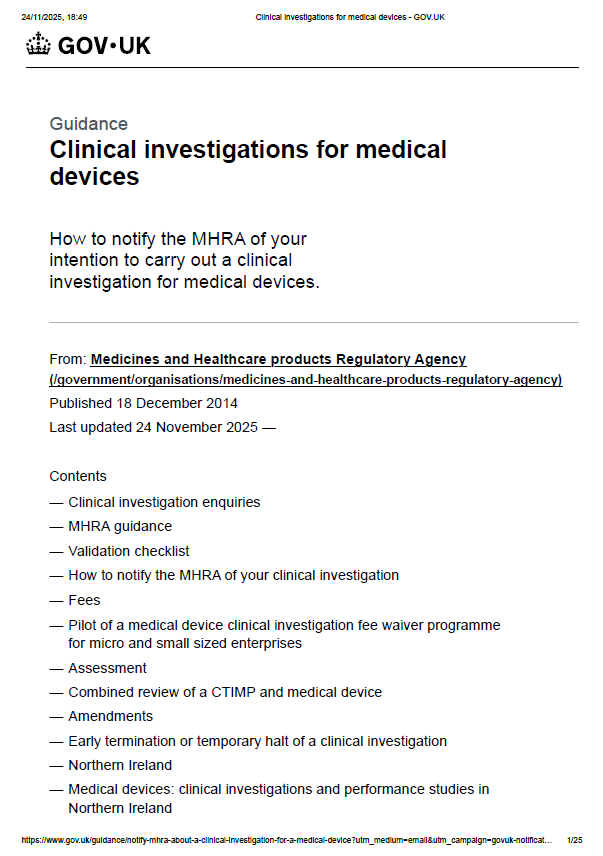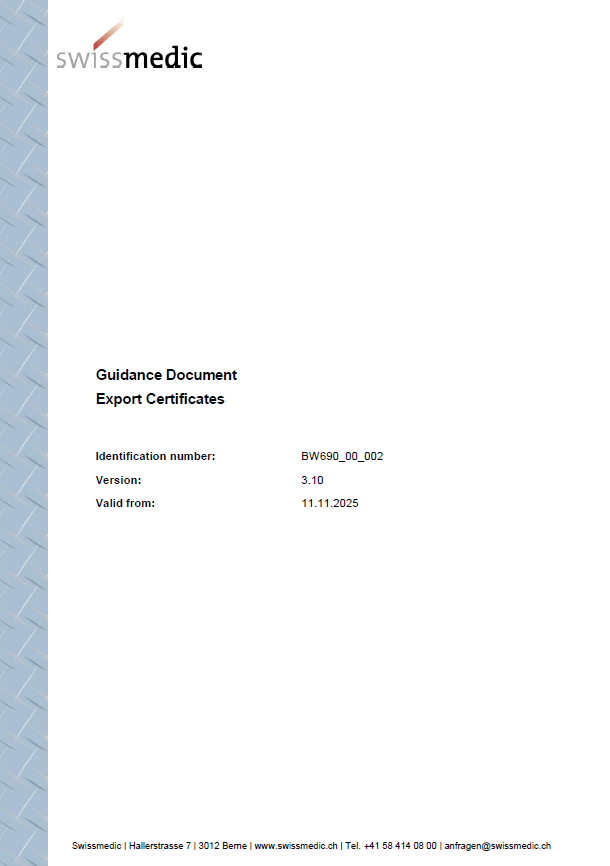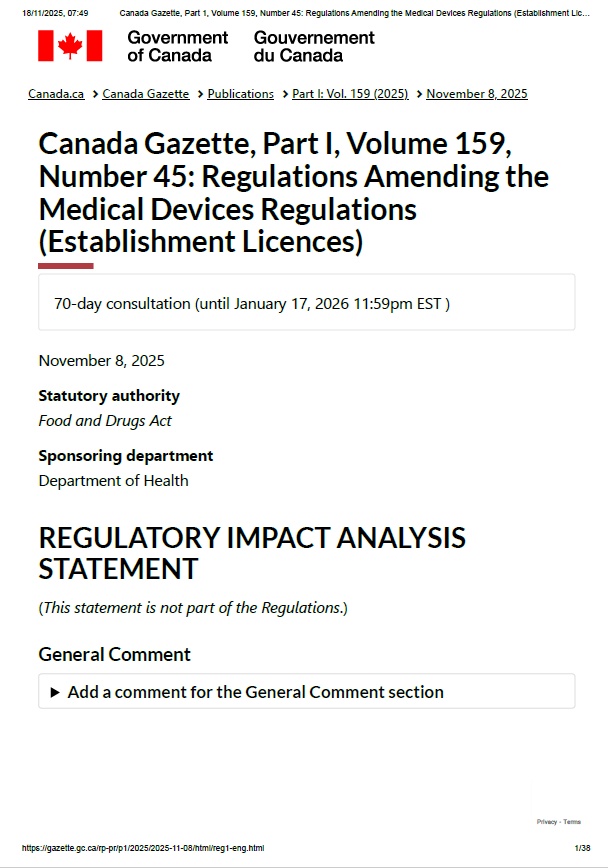Health Canada Adopts the IMDRF Table of Contents (ToC) Format for Medical Device Submissions
Health Canada has adopted the IMDRF Table of Contents (ToC) structure for medical device submissions, streamlining dossier preparation and supporting global regulatory convergence. The updated guidance outlines requirements for pre-market and post-market submissions and clarifies expectations for electronic filing, templates and documentation. Essential reading for manufacturers targeting the Canadian market.
MHRA Publishes Updated Guidance on Clinical Investigations for Medical Devices: Key Implications for Manufacturers
The MHRA has published updated guidance on clinical investigations for medical devices, detailing the requirements manufacturers must meet when planning and conducting investigations in Great Britain. The update strengthens documentation expectations, safety requirements and regulatory oversight, making it essential for all manufacturers preparing UK submissions.
Swissmedic Updates Guidance on Export Certificates: Key Implications for Medical Device Manufacturers
Swissmedic has released updated guidance on the requirements for obtaining export certificates (Free Sales Certificates) for medical devices, introducing clearer rules for manufacturers on documentation, conformity evidence, product grouping, and submission procedures. The revised framework is essential for manufacturers exporting devices to global markets that require FSCs as part of their regulatory registration.
Health Canada Launches Phase II of the MDEL Modernization Framework: Key Impacts for Manufacturers
Health Canada has released Phase II of its Medical Device Establishment Licensing (MDEL) Modernization Framework, introducing enhanced compliance expectations, strengthened oversight of foreign manufacturers, updated documentation requirements and a stronger focus on post-market safety. These changes are essential for manufacturers exporting medical devices to Canada.
MHRA Updates Guidance on Clinical Investigations – What Manufacturers Need to Know
The MHRA has released updated guidance for clinical investigations of medical devices in the UK, outlining new requirements for manufacturers, including application validation, safety reporting, UKCA/CE/CE UKNI considerations, and updated processes for studies in Great Britain and Northern Ireland. Medical device manufacturers must review these regulatory changes to maintain compliance, ensure timely clinical investigation approvals, and prepare robust technical documentation aligned with UK and EU regulatory frameworks.
Swissmedic Reinforces Signal Management and PSUR Requirements for Veterinary Medicinal Products
Swissmedic’s updated guidance on PSUR Signal Management sets a higher standard for pharmacovigilance in Switzerland. By aligning with EU Regulation 2019/6 and VICH GL 29, it requires manufacturers to strengthen PSUR reporting, signal evaluation, and safety data traceability. For medical device and IVD producers, this shift underscores the importance of robust post-market surveillance and regulatory readiness. Smart MDR supports companies in navigating these evolving frameworks efficiently and confidently.
FDA Draft Guidance Aligns QMS Requirements with ISO 13485: What It Means for Medical Device Manufacturers
The FDA has released a draft guidance aligning U.S. Quality Management System (QMS) requirements with ISO 13485:2016. This change simplifies compliance for medical device and IVD manufacturers and distributors, ensuring global harmonization and streamlined FDA premarket submissions effective February 2026.
Team-NB's New Code of Conduct: Towards a More Harmonized and Transparent Evaluation
The new version of the Team-NB Code of Conduct establishes principles of transparency, coherence and quality in the work of Notified Bodies operating under the MDR and IVDR regulations. The document presents clear criteria for audits, technical review, management of conflicts of interest, use of external experts and deadlines for responding to non-conformities.
MDCG 2019-11 Rev.1 - New guidance on qualification and classification of software as a medical device or in vitro diagnostic medical device
The new revised version of the MDCG 2019-11 (Rev.1) clarifies the qualification and classification of software as a medical device (MDSW ) and in vitro diagnostic software (IVD), in the context of the MDR and IVDR. The document covers classification rules, integration with AI Act and EHDS, and includes practical and up-to-date examples. Smart MDR supports MDSW manufacturers in managing compliance and technical documentation.
UK publishes new model periodic safety report (PSUR) for medical devices - MHRA 2024
The MHRA has published a new Periodic Safety Update Report (PSUR) template for medical devices in the UK, in line with the UK MDR. The document details how manufacturers should structure their post-market monitoring (PMS) reports, including performance data, surveillance, PMCF and benefit-risk profile analysis.
Health Canada publishes new guidelines on the use of technical standards to demonstrate compliance with the Medical Devices Regulations
In January 2025, Health Canada published a new guide on the use of recognized standards to demonstrate compliance with the requirements of the Medical Devices Regulations. The document guides manufacturers in preparing submissions, updates and lifecycle management of applicable standards.
MDCG publishes guide on the joint application of the MDR, IVDR and AI Act: what manufacturers should know
The new MDCG 2025-6 guide, published in June 2025, clarifies the joint application of the AI Act and the European MDR/IVDR regulations for medical devices and IVDs with artificial intelligence systems. The document addresses classification, risk management, life cycle, technical documentation and post-market monitoring. Smart MDR supports manufacturers in integrating these requirements into their quality management system and preparing for audits.
MDCG 2025-4: new guidance for the secure provision of MDSW apps on online platforms
The MDCG has published guidance 2025-4, which clarifies the responsibilities of manufacturers of software as a medical device (MDSW) and operators of online platforms that make these apps available in the European Union. The guidance addresses the application of the MDR, the IVDR and the Digital Services Act (DSA), and reinforces labeling, traceability and transparency requirements. Smart MDR supports manufacturers and platforms in regulatory compliance and adaptation to the new obligations of the European digital market.
Health Canada begins canceling MDEL licenses for failure to comply with annual review
Health Canada has begun automatically canceling MDEL licenses for operators who have not complied with the mandatory annual review. The measure affects distributors and importers of medical devices in Canada and has serious consequences, such as interruption of operations, the need to resubmit license applications, and product retention.
NIST publishes new version of cyber incident response guide, now part of Cybersecurity Framework 2.0
The new Revision 3 of NIST SP 800-61, published in April 2025, redefines incident response as an integral part of cyber risk management, now aligned with the Cybersecurity Framework 2.0. The guide covers everything from preparation and detection to recovery and continuous improvement. Smart MDR supports medical device manufacturers and SaMDs in implementing incident response processes in line with the requirements of the MDR, IVDR, FDA and international standards such as NIST.
EUDAMED: Updated Guide to Legacy Device Registration Now Available
The new EUDAMED Guide to the Registration of Legacy Medical Devices provides detailed and practical instructions for manufacturers operating under the MDD or AIMDD directives. The transition to MDR requires legacy devices to be identified with EUDAMED DI and EUDAMED ID, even in the absence of a UDI-DI. This registration in the EUDAMED database is essential to ensure regulatory compliance and maintain the placement of devices on the European market.
Coverage of MDR/IVDR Codes by Notified Bodies: June 2025 report highlights critical areas with low designation
The June 2025 report on the coverage of MDR and IVDR designation codes by notified bodies provides an updated view on the availability of designated bodies for specific categories of medical devices and in vitro diagnostic medical devices. It identifies critical areas with lower coverage, such as active implantable medical devices (codes MDA 0101 to MDA 0104) and devices originating from human tissues (MDS 1002), as well as IVDs for blood and tissue typing (codes IVR 0101 to IVR 0202). For medical device manufacturers seeking certification under Regulation (EU) 2017/745 or Regulation (EU) 2017/746, analysis of these codes is essential to plan the submission of applications to notified bodies with adequate coverage.
MHRA updates guidelines on the classification of borderline products with medical devices in the UK
The MHRA has published a new version of the guide to classifying borderline products with medical devices. This update clarifies the criteria used in the UK to determine whether or not a product is a medical device, with a direct impact on cosmetic products, food supplements and others with therapeutic claims. If you operate in this market, it is essential to review the declared purposes, clinical evidence and regulatory framework.
FDA publishes labeling recommendations for hernia mesh: focus on safety and proper device selection
The new FDA guidance proposes improvements in the labeling of surgical hernia mesh, with the aim of reducing adverse events and facilitating device selection by healthcare professionals. Among the recommended data are mesh composition, physical characteristics and mechanical properties. The initiative applies to devices specifically indicated for hernia repair and encourages manufacturers to update the labeling in their submissions to the FDA.
New version of the MIR form (v7.3.1) published on June 4 reinforces alignment with IMDRF coding
Version 7.3.1 of the MIR form, published by the European Commission on June 4, 2025, introduces new requirements for reporting serious incidents involving medical devices and IVDs.



















